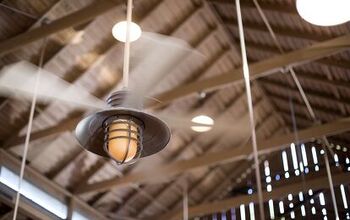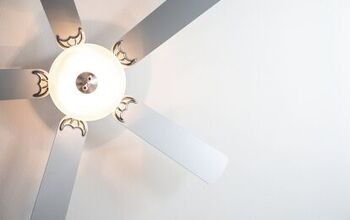Is A Ceiling Fan In The Kitchen A Yes Or No? (Find Out Now!)

Many believe it’s a great idea to have a ceiling fan in the kitchen to keep the room cool. But with so many electric appliances in the room, is it safe to add a ceiling fan to the mix? When it comes to ceiling fans in the kitchen, is it better to have one or not?
Installing a ceiling fan in your kitchen comes with many more advantages than drawbacks. A kitchen ceiling fan maintains comfortable temperatures, provides an extra light source, and keeps the kitchen clear of smoke. Plus, ceiling fans come in a variety of styles, so you’re sure to find one that matches your design scheme.
Need to Hire a Kitchen Remodel Contractor?
Get free, zero-commitment quotes from pro contractors near you.

Pros of Ceiling Fan In Kitchen
There are many benefits of putting a ceiling fan in your kitchen. First, you’ll have continual fresh air that can cool the area by as much as 10 degrees. The constant airflow provided by overhead ventilation is undoubtedly a huge advantage of kitchen ceiling fans.
Can Be Used Year-Round
Not only can a ceiling fan keep you cool, but it can also keep you warm in the winter months. Many fans have blades that, when reversed, draw cool air upwards and make the room feel warmer. Therefore, ceiling fans can be used throughout the entire year.
Various Styles And Designs
Aside from maintaining a comfortable temperature in your kitchen, ceiling fans have many other benefits. They come in a variety of designs and styles, helping you to add to your home’s design scheme. And unlike box fans and other cooling methods, they don’t add clutter to the room.
Take a look at the 5 best kitchen ceiling fans that vary in style.
Additional Light Source
Ceiling fans can add an additional light source to your kitchen. They’re also energy-efficient, keeping your electric bill low and only costing a few cents a day to run.
Keeps Kitchen Clear
A kitchen ceiling fan can safely cool a large area, circulate stagnant air, and remove cooking smells. In the case of kitchen mishaps, a ceiling fan clears out smoke. Finally, its constant rotating movement is a natural deterrent for pesky bugs, such as flies.
Cons of Ceiling Fan In Kitchen
Although it’s clear that having a kitchen ceiling fan comes with advantages, there are a few downsides as well. Of course, it’s necessary to install your ceiling fan, which may come with some challenges. You may need to hire an electrician to set up the wiring correctly.
Ceiling fans can be noisy at times, but selecting a fan with a quiet motor solves this problem. They can also be difficult to clean. In the case of a lower ceiling, a ceiling fan may present a hazard for taller individuals as well.
How Do Ceiling Fans Work?
As your ceiling fan’s blades move counter-clockwise, hot air rises upwards. The force of the spinning blades sucks the hot air up towards the fan. There it is cut, accelerated, and pushed back down into the room as a cool breeze.
A downdraft is created when the fan blades push rising warm air back down. As the heat is pushed down, cool air fills the vacuum left behind. This is how air is circulated by your ceiling fan.
By changing the direction that air travels, a ceiling fan makes a noticeable difference in the temperature of the room. In fact, a ceiling fan can make a room feel as much as five to ten degrees cooler! You can use LED bulbs in ceiling fans to maximize efficiency.
Types of Ceiling Fans
When choosing a ceiling fan for your kitchen, it’s wise to be aware of the most common types. Depending on what you’re looking for in a ceiling fan, you may prefer one over another.
Standard Ceiling Fans
You’ll find this type of ceiling fan in the majority of homes. It typically features four or five blades and a built-in light fixture. Standard ceiling fans come in a vast array of styles, so you can choose one that matches your decor.
Low-Profile Ceiling Fans
Low-profile ceiling fans are also referred to as hugger fans and flush mount ceiling fans. They are recommended for ceilings less than eight feet tall. Because low-profile ceiling fans are closer to the ceiling, they don’t provide as much air movement as standard ceiling fans.
Energy Star Ceiling Fans
Energy Star ceiling fans cost less money to run and are better for the environment than most fans. They must use at least 20% less energy than required by federal standards to get the Energy Star rating. These ceiling fans have aerodynamic blades and efficient motors.
Dual-Motor Ceiling Fans
Just like the name implies, dual-motor ceiling fans have two motors. Two horizontal rods, each with its own fan head, attach to a central motor housing. Each fan head can be set to different speeds.
Dual-motor ceiling fans are often used in public spaces because they can cover wide areas. They’re also capable of circulating air in a specific direction. They’re considered more unique and decorative than most other types of ceiling fans.
Remote-Controlled Ceiling Fans
A remote-controlled ceiling fan can be any of the fan types above, except that they are controlled by a remote. This is great for ceiling fans that are too high to reach, as well as for people with mobility issues.
What To Look For In A Kitchen Ceiling Fan
If you’ve decided to purchase a kitchen ceiling fan, there are a few characteristics you should look for.
Size And Style
First, you’ll want to pick a fan that matches the style of your kitchen design scheme. Ensure that the size of the fan won’t prevent you from opening cabinets or accessing anything in the kitchen.
Three-Speed Motor
Next, look for a ceiling fan with a three-speed motor. This allows you to adjust the speed of the ceiling fan as needed.
Reversible Blades
Be sure to pick a fan that has reversible blades so that you can use it year-round. Blades that can be reversed will keep you warm in the winter and cool in the summer.
Built-In LED Light
It’s always smart to choose a kitchen ceiling fan with a built-in LED light. If you’ve spent time cooking, then you understand the importance of a well-lit kitchen. Plus, LED lights won’t run up your electric bill.
Quiet Motor
You may want to select a fan with a quiet motor so you can ensure it’ll run softly and smoothly. Of course, a noisy ceiling fan isn’t as problematic in the kitchen as it would be in a bedroom. However, it can still be an annoyance, so a kitchen ceiling fan with a quiet motor is a good choice.
Special Features
If you’re more technologically-inclined or have a large budget, you may want to look for a fan with special features. For example, you can find ceiling fans with smart connectivity, remote controls, or wall control panels. These types of features will make your kitchen ceiling fan even simpler to use.
Related Questions
Is it safe to have a ceiling fan in the kitchen?
As with all electric appliances and fixtures, ceiling fans can be a fire hazard if wired incorrectly. However, as long as your ceiling fan is installed properly, it is safe to have in your kitchen.
What size ceiling fan is best for small kitchens?
There are ceiling fans as small as 23” available for purchase. However, the fan size you’’ll need is determined by the specific dimensions of your kitchen. Ensure that the fan you choose won’t interfere with the opening of cupboards and cabinets.
Is a ceiling fan an appliance?
Generally, ceiling fans aren’t considered appliances. Since they’re usually permanent, in a fixed location, and sold as part of a house, ceiling fans are considered fixtures.
Need to Hire a Kitchen Remodel Contractor?
Get free, zero-commitment quotes from pro contractors near you.

Ceiling Fan vs. No Ceiling Fan In Kitchen: The Final Verdict
The bottom line is that even though ceiling fans come with a few drawbacks, the advantages vastly outweigh them. A kitchen ceiling fan maintains comfortable temperatures year-round for a low cost. It can provide an extra light source or even serve as the primary light source for your kitchen.
Plus, there are ceiling fans in a variety of sizes and styles. Some even come with a wall control panel or a remote! This makes it easy to find a ceiling fan that matches your kitchen and meets all of your expectations.
Related Articles

With a lifelong passion for writing plus strong enthusiasm for home improvement and DIY projects, joining the team at Upgraded Home was an easy choice. Jessica Allen likes to share helpful information with current and aspiring homeowners. Aside from writing, Jessica loves doing yoga, playing the piano, and dabbling in graphic design.
More by Jessica Allen



























